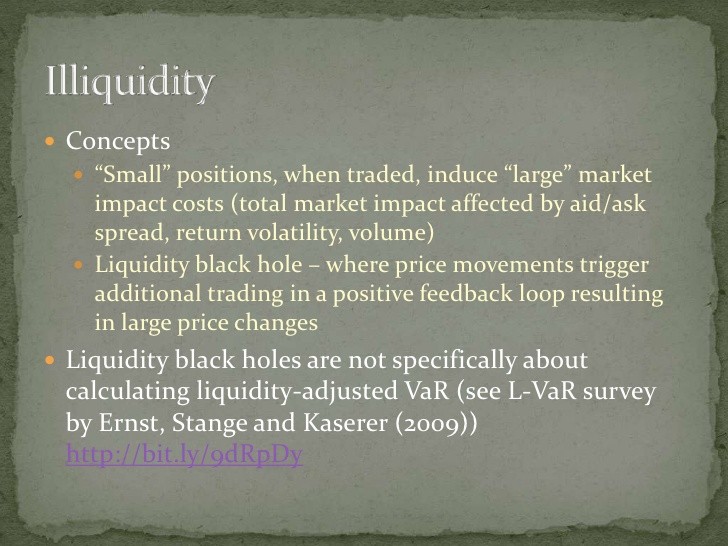Risk Holes and Liquidity Risk Definition and Examples
Post on: 23 Сентябрь, 2015 No Comment

Risk Holes and Liquidity Risk describe the basic dimensions of financial price risk used by derivatives end-users and financial institutions to describe their exposure to fluctuations in financial prices are the delta, gamma and vega values.
Liquidity Risk
In addition to this quantification of the effect that movements in spot and implied volatility can have on the value of a derivatives position, there is also the risk of a liquidity vacuum.
A liquidity vacuum is the nightmarish scenario that occurs when bid/offer spreads for the financial instruments, particularly derivative instruments, widen out to levels that make dealing with them prohibitively expensive.
In exchange-traded markets, there is a legal requirement for market makers to show prices to their customers. In some markets, the bid/offer spread size is capped. Market makers are protected by the authorities of the exchange, who will suspend trading in a particular instrument or who will temporarily stop trading if a particular instrument looks susceptible to a run.
It is important to note that liquidity risk can enter into markets for financial instruments that are being sold en masse or that are popular purchases. In the latter case, it may be impossible to secure supply of the underlying stock, causing the stock’s price to “gap” or jump at discrete, large intervals.
Risk Holes
There are many definitions of the term risk hole. Some derivatives professionals use different terms to refer to the same phenomenon.
Related Article
A risk hole occurs in a portfolio of assets if, for a specific region of one or more parameters relevant to the pricing of the assets in the portfolio, the exposure to great loss is localized and unhedged.
The classic example of this is the position of the market-maker in a one-sided market.
Consider the case of a Canadian dollar Forex options trader during a Quebec separation referendum.
Each of his customers will be paying him for out-of-the-money US dollar calls/Canadian dollar puts in every period that includes the referendum date. No matter how much of a premium in terms of implied volatility (when compared to the at-the-money options for the same period) he charges for those out-of-the-money Canadian dollar puts, the customer will pay his offer.
What does this mean? He has (at least) two kinds of risk hole here.

First, he is exposed because he will be very short gamma if spot trades higher and get shorter and shorter gamma the higher spot goes. This means that he will lose increasing amounts of money if spot trades higher and his position gets shorter and shorter US dollars (and longer and longer Canadian dollars) at an accelerating rate.
Second, if spot does trade higher, it is likely that implied volatility will jump as well. If spot trades higher, the options market maker will be getting shorter and shorter vega, at an accelerating rate.
Third, if spot trades higher, the forward points are likely to move to the right due to the spike higher in Canadian interest rates. This will have the effect of compounding his gamma and vega problems.
These are just the risk holes that derive from market risk. In addition, there are operational risk holes as well. The options dealer will face a liquidity vacuum in the spot market. He will need to buy US dollars against Canadian dollars aggressively as the Canadian dollar collapses. The kicker is that he will have a more difficult time doing so as the spot market dries up. He will have an even more difficult time hedging his exposures in the options market and the forward market.
Risk Holes From Ignorance
Risk holes can also arise because of the ignorance of the end-user about the behavioural characteristics of the product they are dealing with. Now imagine the naïve fund manager who thinks that the market is overdoing this premium for out-of-the-money US dollar calls/Canadian dollar puts. Naturally, he sells them. He has all of the problems described above that face the market maker. Chances are he does not earn the bid/offer spread on the transaction (that has naturally inflated due to the panic about the uncertainty of the separation referendum’s outcome). Nor will he have the direct access the options market maker has to the underlying markets.
What is worse, let us imagine that he does not have the systems or the training to assess and measure his exposure to these risks. He could stand to lose all of his fund’s money and more in the worst-case scenario. Understanding risk involves breaking it down into terms that we can manage. Managing risk means, in many cases, avoiding risk holes and smoothing exposures so that they fit into reasonable tolerances, while still positioning ourselves to take advantage of favorable market moves, if and when they occur.
- Article by Chand Sooran. Point Frederick Capital Management, LLC














